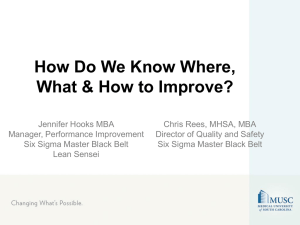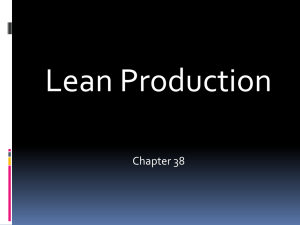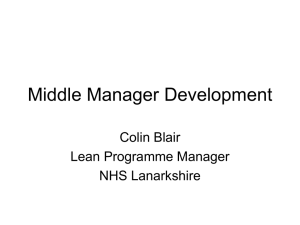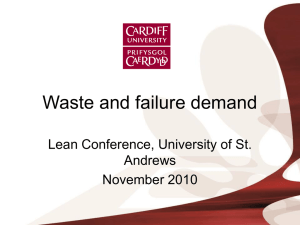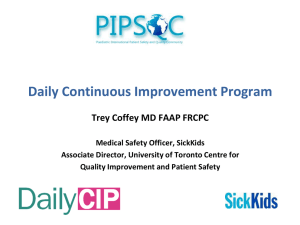LEAN 5S Webinar Slides
advertisement
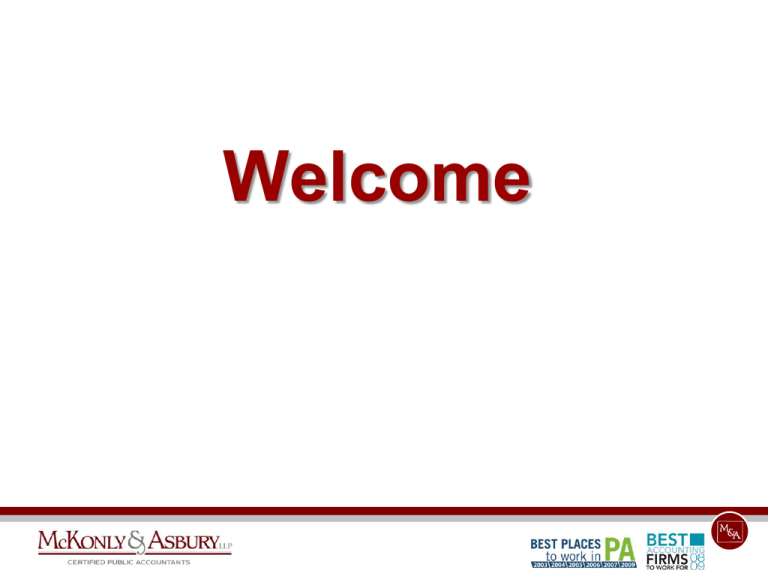
Welcome Slides and a recording of the presentation will be available on our blogs at: www.macpas.com/manews and www.leanaccountants.com 5S – Workplace Organization and Standardization About David Blain, CPA/ABV, CVA • • • • Principal in the Audit and Assurance Practice Unit Practice leader of the Construction and Manufacturing Group Certified as a LEAN Professional through the MANTEC LEAN Certification Program Board and Executive Board Member of MANTEC Agenda • Understanding LEAN • The Eight Deadly Wastes of LEAN • Defining and Understanding the 5S Concept • Wrap up Understanding LEAN The House of LEAN Definition of LEAN An organization-wide approach to creating an environment which allows a company to supply products paced by the demand of their customers with as little waste as possible. Defining LEAN Environment When a company’s system-wide approach shifts from maximizing utilization and productivity to maximizing information flow and elimination of waste. A LEAN Enterprise Focuses on FLOW Individual Efficiency vs. System Efficiency Shifting Paradigms! Basic Components to LEAN • Defining Value Added versus Non Value Added Efforts. • Defining the “Eight Deadly Wastes.” What is Value-Added? • Value Added – Any activity that changes the fit, form, or function of a service. – The customer must be willing to pay for these activities. • Non-Value Added – Any activity that does not change the fit, form, or function. The customer is not willing to pay for these. They must become the focus to be reduced or eliminated. The Eight Deadly Wastes Defining the “Eight Deadly Wastes” DOWNTIME • • • Defects – Inspection and rework of defective work product. i.e. weak process capability. Overproduction – Doing more than is required. Performing more work than benefits the client or product. Waiting Waste – Idle time created when waiting for ____? i.e. unplanned downtime. Defining the “Eight Deadly Wastes” con’t. • Non-Value Add Processing – Non-value added activity within the process. i.e. redundant efforts. • Transportation Waste – Transporting parts and materials around the plant. i.e. poor plant layout and misaligned process flows. • Inventory Waste – Any supply in excess of real customer demand. i.e. production buffers or excess queue times. Defining the “Eight Deadly Wastes” con’t. • Motion Waste – Any movement of people or machines that does not add value to the product or service. i.e. unorganized workspace. • Employee/People Waste – The waste of not using people’s mental, creative, and physical abilities. i.e. misaligned process flow. Defining and Understanding the 5S Concept The Definition of 5S • • • • • Sort. Set in Order. Shine. Standardize. Sustain. A Fundamental Strength – The 5S Vision • A workplace that is: – Clean, organized, orderly. – Safe. – Efficient and pleasant. – The foundation for all other improvements activities. • Resulting in: – – – – Fewer accidents. Improved efficiency. Improved quality. Workplace control. • And therefore… - Reduced waste. - Reduced cost. Getting Started: Workplace Scan • Getting Started: –Form a core implementation team. –Identify a project. –Perform a workplace scan. –Create a workplace scan display. Tips for Getting Started • • • • Map the current process. Go to where the action is. Use a checklist to gather information. Create a display in the target area. 5S Step 1 - Sort • What is needed? What is not? – Sort through items in the area. – Keep what is needed. – Eliminate what is not needed. – Reduce the number of items to the quantity. required at any given time. Tips for Sorting • • • • Determine sort criteria. Determine holding areas for information. Develop sort log of information. When sorting, ask yourself: – Does it have a function in this area? – Is it needed? How often? By whom? Step 2 – Set in Order and Set Limits • Definition: A place for everything and everything in its place. • Procedure: – Identify best locations. – Relocate out of place items. – Set height and size limits. – Focus on safety. – Install temporary location indicators. A Few Guidelines • Look for the “low hanging fruit” first: – Carry out the easy decisions. – Make low cost decisions. • Get worker buy-in, its their work area. • This is the test phase, you can make changes later. Step 3 – Shine • More related to actual manufacturing environment. • Focus is on elimination of sources of contamination through cleaning. • For a back office function focus should be on: – Control of information. – Use of visual controls for information. Inspect through Cleaning • Check to see if everything is in its place, i.e. stored in correct drive. • Check to see if you need to replace anything. • Check specific information targets for necessary changes. Step 4 – Standardize and Share Information • Maintain the first 3 S’s: – Uniform standards. – Clarity about what is and is not normal. – Create and use checklists. – Establish a simple action plan. – Make everything visually apparent. A Shift in Thinking • • • • Understand the 30 Second Rule. Know the “one is best” concept. Move from individual to group ownership. Ensure that 5S is an essential part of daily work. • Enable workers to manage and control their area. Guidelines for Standardization • Make standards obvious and easy to understand. • Ensure information is on or near the operation or function it relates to. • Make standards understandable by anyone. • Ensure that 5S standards accomplish their purpose. Step 5 - Sustain 5. Sustain • Sustain through Self-Discipline: – Make procedures a habit. – Properly train all workers. – “Buy in” from workers and a change in work habits has been achieved. – The workplace is well-ordered and run by agreed upon standards. 5 Necessary Conditions 1. 2. 3. 4. 5. Development of new awareness skills. Support from management. Ongoing communication. 5S is part of daily work. Total employee involvement (TEI). Where Can I Use 5S? Where Can I Use 5S? • Data Storage: – Hard Files. • AP Invoices. • Cash receipts. • Journal entries, special reports, other information. – Soft Files and Shared Drives: • Excel and Word documents. • Electronic invoices and receipts. • Shared information. Where Can I Use 5S?, cont. • Office supplies. • Financial statement preparation: – Storage of information. – Use of shared information. – Preparation and storage of reconciliations. Why LEAN??? Benefits of a LEAN Enterprise • Improved on-time delivery of service or product. • Improved work quality. • Shorter cycle times. • Reduced internal costs. • System-wide focus on improvement. • Improved profitability through elimination of waste. To LEAN or Not to LEAN • Ask yourself the following questions: – Do you like the current performance of your company? – Is it going to stay that way? – Will you get better if you keep doing the same things? “The definition of insanity is doing the same thing over and over again and expecting different results.” - Albert Einstein • David Blain – dblain@macpas.com – (717) 761-7910 Please visit The LEAN Accountants for more information on LEAN at: www.leanaccountants.com Slides and a recording of the presentation will be available on our blogs at: www.macpas.com/manews and www.leanaccountants.com



